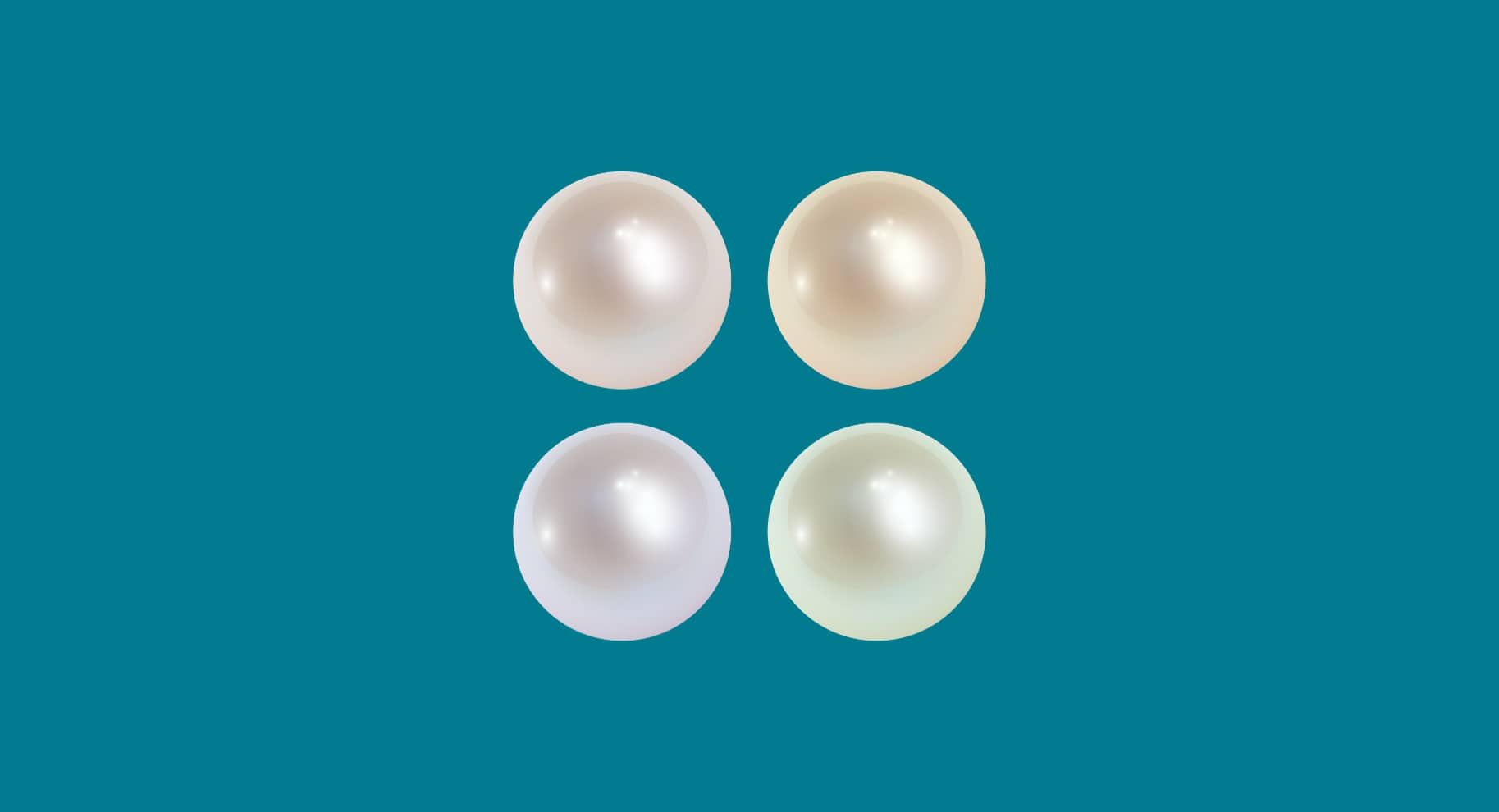Pearls are perhaps the most gifted gems in human history. For good reason, too. They have romantic connections to the sea, and are among the few perfectly round gems found in nature. They’re also soft enough to be worked (to be drilled for string, most commonly) and yet hard enough to remain durable for lifetimes.
But there’s another reason for the popularity of pearls as gifted gems for jewelry, especially in recent times. That is their wide variety of color.
Pearls come in many colors, not only the most well known white and cream colors. The range of colors for pearls extends to every hue, including black, gray, silver, green, blue, purple, pink (also called rosé, like the wine), red, iridescent, and more.
In this article we’ll explore some of the wide range of colors in which you can find pearls.
We’ll also cover what you need to know about
- Naturally colored pearls
- Artificially colored pearls
- How to judge quality
- How to choose colors of pearls for gifts
Different Pearl Colors That You Can Find Today
Here are a few pearl colors that you may see during your buying process:
White Pearls
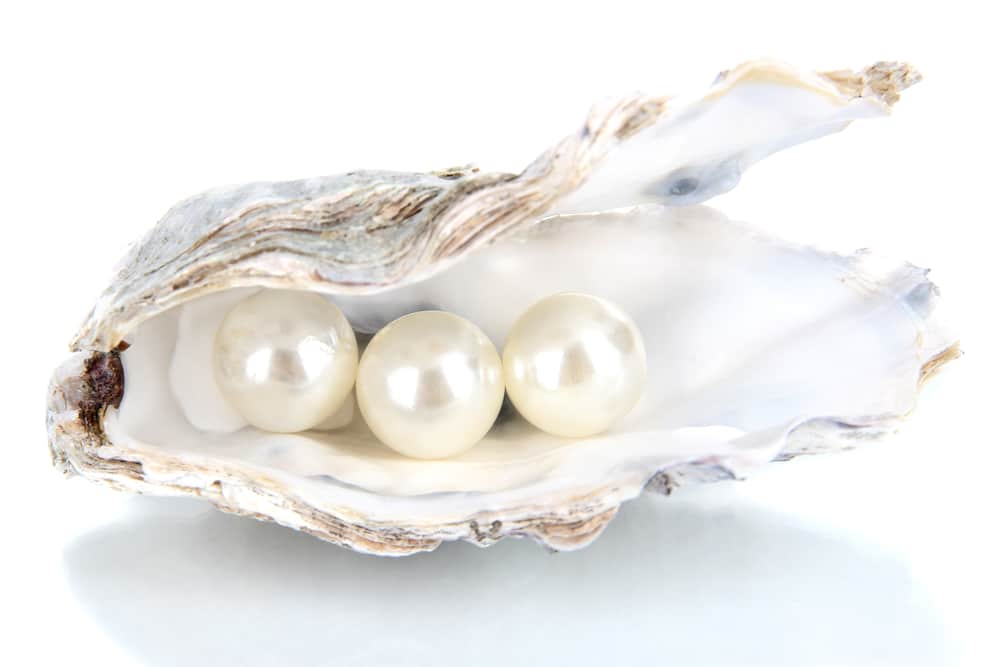
White pearls are the most common and most well known color of pearls. First of all, white is the most common natural color of pearl. White is obviously desired by brides and other attendees at weddings, since the color goes so well symbolically and aesthetically with all things brides.
But the appeal goes far beyond weddings. It’s an elegant, luxurious color which goes with any color of evening dress.
Black Pearls
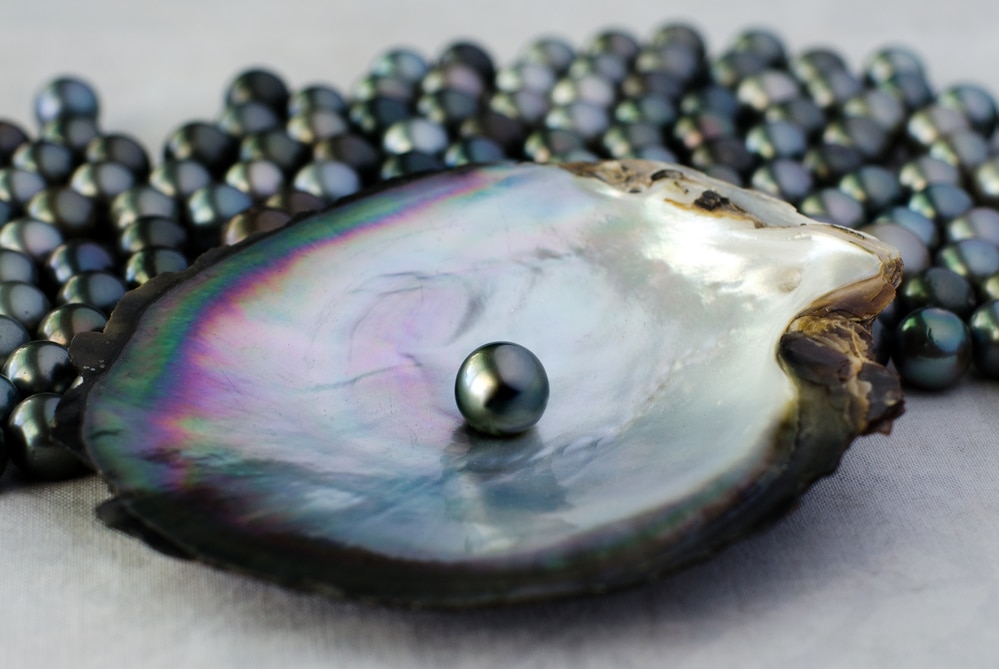
Black Pearls, also called Tahitian pearls because they’re grown in French Polynesia, may be the second the most popular color of pearl. At one time they were rare, but today they are cultured (grown deliberately and en masse), and this brings them within reach of almost everyone.
Black pearls or Tahitian pearls range in hue from dark iridescent green to equally dark and iridescent brown and red, to silvery, to almost black. Black pearls are rich in subdued, almost invisible color which changes in the light.
A beautiful way to gift or wear an enchanting string of black pearls is to select a strand which has many of these different hues. Every inch of the strand is fascinating because every inch is unique. Plus, the varied colors makes the entire string of pearls look much more natural.
Cream Pearls
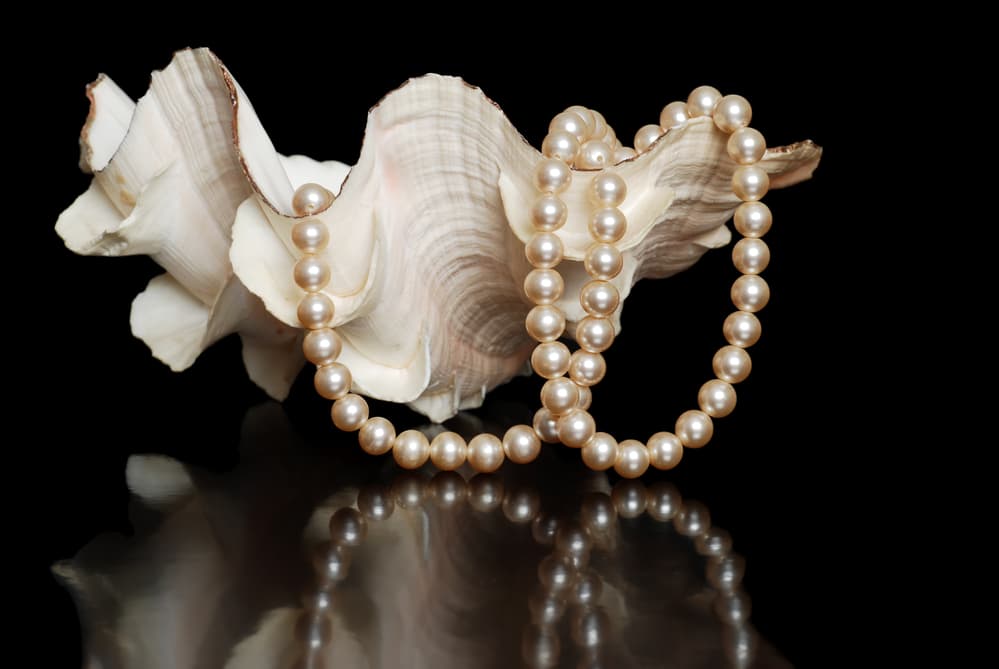
When a person wants a gentler shade of white, the next most common color, cream, is a go-to selection. Chosen for photo ops and red carpet appearances, it’s less harsh in photography, and doesn’t wash out in the final image.
It’s desired far beyond Hollywood or Washington, D.C., for the rich color and its gentle soothing quality on the eyes.
Pink Pearls
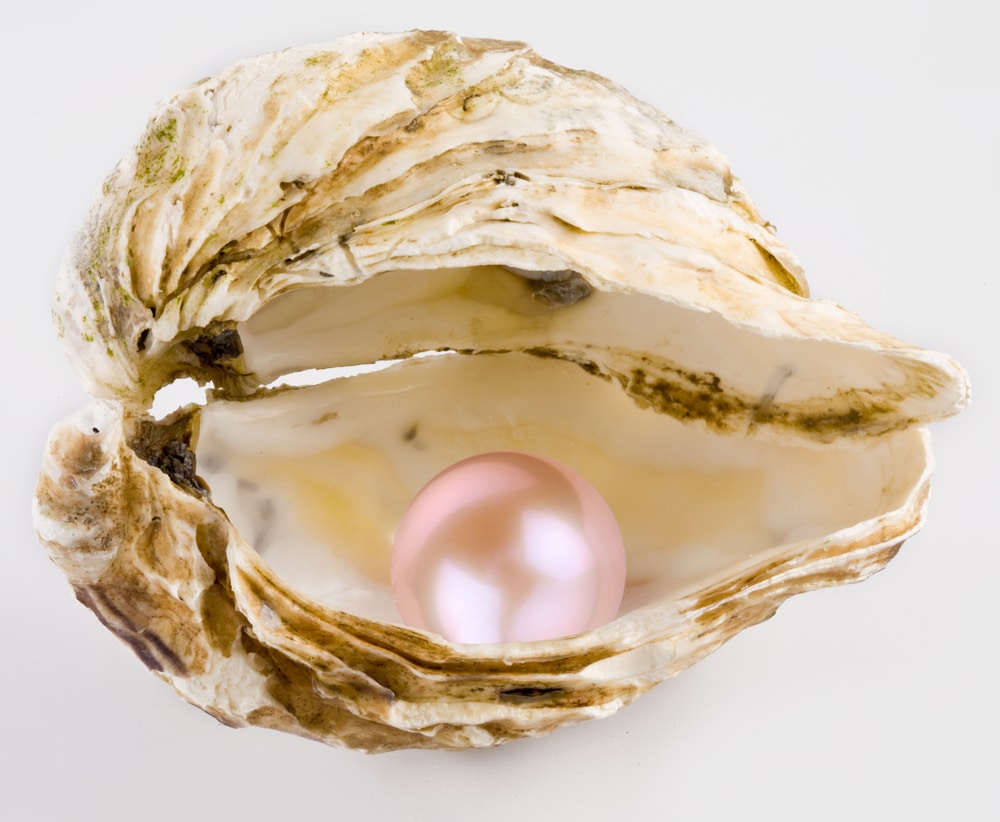
Pink pearls range in hue from baby pink, hardly distinguishable from cream, to peach, to rose colored. They’re often loved for occasions when motherhood or extreme femininity is the effect desired. They also mean romance, loyalty, fidelity, and are often gifted more after years together than are white pearls, which are often gifted near the beginning of a relationship.
(But any color of pearls is appropriate at any time in a relationship. No question about that.)
Gold Colored Pearls
Gold pearls mean success or achievement, and are often gifted at points of achievement in in life, such as graduations, promotions, ascending to partnership in a firm, starting a business, or taking a business to the next level.
Gold colored pearls occur in nature only in certain South Sea species. Various tones include yellow gold shades, greenish bronze, and champagne hues.
Most gold colored pearls you’ll run across have been treated in order to create the gold color. Choose to buy from a reputable retailer who will discuss the treatment your prospective pearls may have received, and you’ll be sure to get good quality.
As with any colored pearl, you can achieve a more natural look by selecting pearls which are all of the same color, but differ slightly in tone or hue.
Purple Pearls
If naturally occurring, purple pearls are a variety of “Black” or “Tahitian” pearls, a deep purple or silvery purple. These are traditional, luxurious, understated, and are a stunning color to wear in fall or winter.
On the other hand, if a purple pearl is one that has been dyed or otherwise treated, it can be any shade of purple under the sun. These treated pearls could look much like natural purple pearls. Or they could shimmer with a fantasy hue of electric purple.
Silver Pearls
Like white or cream pearls, silver colored pearls go with almost any evening or cocktail dress. They’re less commonly worn than white or cream, however, because they can seem harsh in bright light. Also, there’s no doubt they were treated to create the color, since an even, “stainless steel” color of silver in pearls doesn’t occur in nature.
Brown Pearls
Brown pearls, also called chocolate pearls, are often gifted for Valentine’s Day, but can be gifted at any time. They’re desired for certain colors of dress that work better with dark chocolate than with black, white, or cream.
Naturally occurring brown pearls are much rarer than the dyed variety, so just be aware of what you’re buying. The naturally occurring chocolate pearls are much more expensive. They’re also not as uniform in shape and color.
Even well-dyed chocolate pearls can be expensive. It all depends on the quality of the treatment and the final result.
Deal with a reputable retailer, and you won’t go wrong.
Are Colored Pearls Natural or Treated? Why You Should Care
Now that we’ve sampled some of the different colors of pearls, let’s explore in more detail what it means that some pearls are treated with dyes or gamma rays to create various colors.
- Naturally colored pearls will retain their color longer and better.
- Modern dyeing methods can be very effective. It’s not necessarily easy to tell the difference between natural and dyed, bleached, or otherwise treated.
- It’s not necessarily important whether pearls are dyed or not, as long as your retailer is clear with you about what you’re buying. It depends on your preferences, and the quality of the treatment.
- But if the pearls are sold as natural, you should demand of course that they be natural, and verify that to the extent that you can. The best way to be assured is to buy only from highly reputable retailers.
- Two examples of such retailers, based on their BBB scores, TrustPilot, and other scoring systems as well as online reviews, are James Allen and Blue Nile.
- Finally, the best way to be assured you’re getting quality dyed pearls is to also buy from highly reputable retailers.
What Are Some Dangers of Dyed Pearls?
Dyed pearls can fade. They can also just be poorly dyed. For example, if dyeing is done properly, it’s done before the pearls are assembled on a string. But with inexpensive freshwater pearls from China, it’s not uncommon to see that they’ve been assembled on strings, then dyed. You can tell from the uneven dye, and from the odd color of the string.
You won’t run into that at reputable retailers.
Another sign of a cheap dye job is blemishes on the pearl where the dye collected and hardened unevenly.
That said, not all dye jobs are cheap. If done by a quality processor, even obviously dyed, fantasy colored pearls can be quite classy and beautiful.
Also, remember that even natural pearls have “blemishes” such as slightly uneven surfaces or slight discolorations.
If you’re new to buying pearls, then when spending on a high dollar item, my advice is to buy only from a highly reputable retailer, and make sure you understand the return policy. It should be long enough to let you examine the pearls and return them if you’re unhappy.
How to Tell If Pearls Have Been Treated for a Change of Color
It’s not always possible to tell for sure if a pearl has been treated. The best way is to buy only from reputable, established retailers you can trust to be straight with you.
If you’re examining pearls yourself, here are some ways that may help to know if they’ve been treated for a change of color:
- A 100% consistent color of pearls in the necklace is a sign that they’ve been treated. Natural pearls usually vary a little from pearl to pearl, even if they are all of the same kind. Artificially dyed or bleached pearls are of much more uniform color.
- Look into the drill hole of a pearl. If you see concentrations of what seems to be dye, you know you’re probably dealing with a dyed pearl.
- Some pearls are darkened with irradiation of gamma rays. This darkens their centers, or nuclei, more than the outsides of the pearls. When you look into the drill hole, and see a darkened pearl nucleus, you’re probably holding in your hand a pearl that has been darkened with gamma-ray treatment.
- Look closely at every pearl.
- Look for blemishes in the dye (realize that even natural, untreated pearls aren’t perfect — they can show blemishes too, but you can usually see whether that’s in the pearl itself or the dye).
- Look at the openings around the string holes. The dye job shouldn’t show even there, if it’s a quality job.
- Look at the string. Does it look luxurious and strong? Or is it dyed and frayed as if it’s been soaking in bleach water or harsh dyes?
- Remember that even naturally colored pearls can fade somewhat, especially if left in the sun for extended periods of time.
Even perfectly white pearls can be treated pearls
One more point about treatments: there are many more perfectly white pearls in the world than would occur naturally.
Many white pearls are bleached. It’s not necessarily a big deal.
Akoya and freshwater pearls are routinely bleached. All pearls are also cleaned and polished.
How Does a Pearl’s Color Affect Its Cost?
It’s not possible to say one color is more costly than another. The market determines at any given time.
It’s not the color, but the quality of the color. Also whether it’s natural or not. And finally, if it’s dyed, what level of quality it is.
For example, in times gone by, black pearls were very costly because very rare and very much in demand. They were very rare because the only way to get them was for unusually fit and brave divers to plunge deep in the South Sea islands to harvest them.
Nowadays, they’re grown under controlled conditions, or “cultured”. The cultured Tahitian pearl industry has made these black, beautiful pearls available to everyone.
One thing is generally true about pearl color and cost. The more even and beautiful is a pearl’s color, the more costly it will tend to be.
Final Things to Know About Different Pearl Colors
To wrap up, here’s a quick list of the takeaways from this article
- Many pearls on the market are artificially colored. That’s not necessarily a bad thing. It depends on the quality. It also depends on the honesty of your pearl retailer.
- The most desirable colors are naturally colored pearls which haven’t been treated for color change. These can be quite expensive, depending on other qualities of the pearls in question.
- Even artificially colored pearls can be of high quality, expensive, and worthy as gifts.
- With modern dying and gamma-ray treatments, you can find any color of pearl.
- The most popular, most famous, most desired colors are white, cream, and “black” or “Tahitian” pearls. You can’t go wrong gifting or wearing any of these three. Each goes with virtually anything, and are admired and fascinating even more than any fantasy colored pearl.
